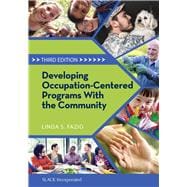Inside Developing Occupation-Centered Programs With the Community, Third Edition, Dr. Linda Fazio includes the importance of community asset identification and development toward sustainability.
The Third Edition includes new and updated content on evidence-based practice; program evaluation at multiple levels; funding; nonprofits and social entrepreneurship. Additionally, new trending issues of interest to programmers include human trafficking, post-combat programming for military veterans and their families, arts-based programming for all ages, and programming to meet current needs of the well-elderly.
Features of the Third Edition:
Workbook format offers the instructor and the student options for how to use the text in a classroom or independently in an internship or residency.
The order of the programming process, chapter content order, summaries, and format of exercises has been retained to ease transition for instructors using previous editions of the text.
The program “story” section has been retained, along with author’s notes on what is currently happening with these programs and other related topic areas
New content has been added in program sustainability, the assessment and building of community assets, and consensus organizing in communities.
More developed content is offered about the structure and function of nonprofit organizations as well as the role and function of the social entrepreneur who does programming for these organizations.
Instructors in educational settings can visit www.efacultylounge.com for additional materials to be used for teaching in the classroom.
Developing Occupation-Centered Programs With the Community, Third Edition is an excellent introductory tool and is a valuable resource for occupational therapy students at all levels, as well as experienced practitioners in a clinical setting.









